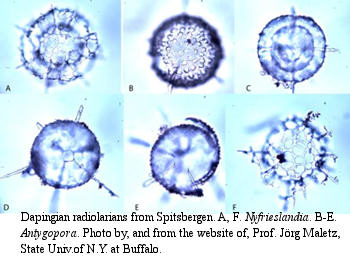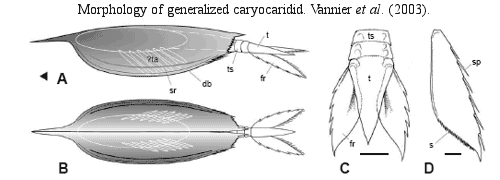
| Palaeos: Paleozoic |  |
Middle Ordovician |
| Ordovician period | Dapingian Age: 1 |
| Page Back | Back: Floian | Back: Early Ordovician | Up: Middle Ordovician | Unit Home |
| Page Next | Next: Darriwilian | Next: Late Ordovician | Time |
| Paleozoic Era Cambrian Period Ordovician Period Early Ordovician Epoch Tremadocian Age Floian Age (Early Arenig) Middle Ordovician Epoch Dapingian Age (Middle Arenig) Darriwilian Age (Late Arenig & Llanvirn) Late Ordovician Epoch Silurian Period Devonian Period Carboniferous Period Permian Period |
Introduction Geography Stratigraphy Dapingian Life Slugs > Bugs (Lophotrochozoa) Bugs > Slugs (Ecdysozoa or whatever) Chordates
|
The Dapingian was a sort of dry run for the Darriwilian and the Great Ordovician Biodiversity Event ("GOBE"). The name of the Dapingian Age, like its global stratotype section, is a little dicey. Daping is the former name of a similar section (and also of a small city) in the Yangtze Gorge area. Wang et al. (2005). Yet Western readers, at least, should be properly grateful that this slice of the Ordovician was not named the "Huanghuachangian" after the actual type section.
 Prior to the Dapingian, it is not entirely clear where Baltica (Scandinavia +
European Russia) was.
Cocks & Torsvik
(2005). Baltica seems to have been drifting in a
generally west-southwesterly direction during most of the Proterozoic.
At some point, as Nawrocki &
Poprawa (2006) describe it, Baltica hit the tectonic equivalent of a
brick wall to the south, near the Gondwanan landmass. The craton
effectively bounced, abruptly changing direction to north-northwest and rotating
counter-clockwise about 55°. This rotation was
completed during the Dapingian, and Baltica was redirected NNW, on a collision
course with Laurentia (North America).
Prior to the Dapingian, it is not entirely clear where Baltica (Scandinavia +
European Russia) was.
Cocks & Torsvik
(2005). Baltica seems to have been drifting in a
generally west-southwesterly direction during most of the Proterozoic.
At some point, as Nawrocki &
Poprawa (2006) describe it, Baltica hit the tectonic equivalent of a
brick wall to the south, near the Gondwanan landmass. The craton
effectively bounced, abruptly changing direction to north-northwest and rotating
counter-clockwise about 55°. This rotation was
completed during the Dapingian, and Baltica was redirected NNW, on a collision
course with Laurentia (North America).
Also during the Dapingian, somewhat west of Baltica, a string of small blocks crumbled off the northern edge of Gondwana and began slowly moving north. These were the Avalonian terranes, which later accreted onto the east coast of Laurentia and the south coast of Baltica, forming "the Maritime Provinces of Canada, Newfoundland, southeastern Ireland, southern Britain, and a substantial area of Europe surrounding Belgium." Cocks & Torsvik (2005). The slowly shrinking gap between Western Avalonia and Laurentia is often referred to as the Iapetus Ocean, while the corresponding waters between Eastern Avalonia and Baltica formed the Tornquist Ocean. The new basin between Avalonia and Gondwana became the Rheic Ocean. It also seems increasingly likely that similar small blocks were being stripped off Gondwana further east, at about the same time. These included parts of Germany and Italy, Greece, and the Czech Republic (= Perunica = Bohemia). Cocks & Torsvik (2002, 2006). However, France refused to join the rest of Europe, much less North America, although its traditional connections with Africa were becoming increasingly strained. Evidently, some things never change [4]. Nysæther et al. (2002).
Laurentia, and most of the other terranes outside Gondwana (Siberia and other pieces of central and northern Asia), were drifting slowly northward into positions around the equator. However, during the Dapingian, none of these lands was significantly north of the equator, with the possible exception of some Mongolian fragments. The South Pole was located in Algeria, and the core West (actually south, in that era) Gondwanan cratons of South America, Africa, Arabia, and India extended northwards on the opposite side of the earth from Laurentia, Avalonia and Baltica. East (then, north) Gondwana formed a massive tail, arching northwest from this core, reaching well north of the equator. Cocks & Torsvik (2006, 2007).
The Dapingian is bracketed by two pulses of rising sea level, without a strong intervening decline. Ghienne et al (2007). The Ghienne paper reflects careful interpretation along a roughly NW/SE transect starting from the coast of Algeria -- thus covering an area very close to the Dapingian South Pole. The authors find no evidence of ice accumulation until the end-Ordovician.
Meanwhile, in the depths of outer space, a very large chondritic body in the Asteroid Belt seems to have been totally disrupted, resulting in a hailstorm of meteoric impacts toward the end of the Dapingian. It has recently been argued that this triggered the GOBE. Schmitz et al. (2008). The mechanism is unclear. ATW080223.
 The
Dapingian corresponds generally with Middle to Late Arenig of Britain, the
Volkhov of Baltica, the Early Whiterockian of North America, the Castlemanian of
Australia, and the Late Yushanian of China. It lies slightly above the
Tripodus laevis conodont zone which, in turn is slightly above the first
appearance of dichograptid graptolites (Benton
& Harper, 1997), within the Azygograptus suecicus
biozone.
The
Dapingian corresponds generally with Middle to Late Arenig of Britain, the
Volkhov of Baltica, the Early Whiterockian of North America, the Castlemanian of
Australia, and the Late Yushanian of China. It lies slightly above the
Tripodus laevis conodont zone which, in turn is slightly above the first
appearance of dichograptid graptolites (Benton
& Harper, 1997), within the Azygograptus suecicus
biozone.
No, we had no idea what all that meant, either. But, unlike you, we looked it up. A useful table of graptolite theca morphologies, lifted from the China University of Geosciences site, is reproduced above. According to Zhang & Chen (2003), the A. suecicus biozone "is defined by the FAD [first appearance date] of the zonal species [A. suecicus] which has proved to be rather common in both the Yangtze region and Jiangnan Slope regions, as well as in Scandinavia and Britain. However, the equivalent interval in Australasia and in the Zhujiang region of South China is characterized by the occurrence of isograptids and allied groups." Their Figure 2(B) shows a rough sketch of the infamous A. suecicus itself, as well as its isograptid sisters, cousins, aunts, etc.
We will move on, as we are unequal to the daunting task of making this material sound interesting. This is a pity, since it has many redeeming features. At this level, stratigraphy is perhaps best understood as a four-dimensional jigsaw puzzle the size of a planet, with billions of pieces. It is intimidating, tedious, frustrating -- but somewhat addictive. ATW080224, rev'd ATW080305.
 The Dapingian saw a very modest radiation of animal life. The importance of
the Dapingian radiations was not their size, or even novelty, but the
selectivity
of the groups which were diversifying. The Early
Ordovician radiations equally affected the older
Cambrian fauna and the new groups which had
arrived at the end of the Cambrian and
earliest Ordovician. The Dapingian saw (a) the replacement of the Cambrian fauna by a Mid-Paleozoic biota
and (b) the radiation of the same taxa into specialized forms capable of
invading level-bottom shelf and open pelagic communities, ecosystems which had
not previously had an animal component.
The Dapingian saw a very modest radiation of animal life. The importance of
the Dapingian radiations was not their size, or even novelty, but the
selectivity
of the groups which were diversifying. The Early
Ordovician radiations equally affected the older
Cambrian fauna and the new groups which had
arrived at the end of the Cambrian and
earliest Ordovician. The Dapingian saw (a) the replacement of the Cambrian fauna by a Mid-Paleozoic biota
and (b) the radiation of the same taxa into specialized forms capable of
invading level-bottom shelf and open pelagic communities, ecosystems which had
not previously had an animal component.
These changes were particularly marked (or at least well-known) in the shallow seas covering the Great Basin of Western Laurentia (Nevada, Utah, Arizona). Shell beds came to be dominated by brachiopods and ostracodes, rather than trilobite exoskeletons. Pelagic radiolarians diversified and developed one or (as with many extant forms) more spherical shells, along with the pelagic graptolites. Conodonts and graptolites also made notable gains. Webby (2004a). Encrusting bryozoans and crinoids became more common on hard substrates. Taylor & Wilson (2003). ATW080229
 Brachiopods seem to have led the way, replacing some of the benthic trilobite
clades.
Schmitz et al.
(2008).
Strophomenoids, particularly the plectambonitoids, were quite successful (Cocks
& Torsvik, 2005), but
linguliform brachiopods began a slow
decline
(Webby, 2004a).
Stonolaemate bryozoans built gradually on the foundation they had laid in
the Early Ordovician.
Benton & Harper (1997).
Brachiopods seem to have led the way, replacing some of the benthic trilobite
clades.
Schmitz et al.
(2008).
Strophomenoids, particularly the plectambonitoids, were quite successful (Cocks
& Torsvik, 2005), but
linguliform brachiopods began a slow
decline
(Webby, 2004a).
Stonolaemate bryozoans built gradually on the foundation they had laid in
the Early Ordovician.
Benton & Harper (1997).
Among mollusks, the explosion of nautiloids occurred in the Darriwilian, but the higher level taxa had diverged by the end of the Dapingian. These may have evolved as endemic forms, but all responding to some selection for greater buoyancy control. Frey et al. (2004); Kröger (2004); Webby (2004a). By contrast, other mollusk groups found the Dapingian less congenial. In the gastropod lineage, the pre-gastropod bellerophontids made little headway. The Euomphalida and Macluritoidea radiated in the earlier Dapingian, but were already in decline by the end of the age. Bivalves had a small radiation, but the rostroconchs began to slide toward their extinction at the end of the Ordovician. Webby (2004a).
On the rare occasions when we are forced to comment on the state of the annelids, we usually occupy the space with complaints about the poverty of the fossil record. We have recently learned that machaeridians are armored annelids, so we may have to mend our ways. Vinther et al. (2008); see Christopher Taylor's (2008) Catalogue of Organisms- Yay, Machaeridians!, with citations and absolutely gorgeous illustrations therein. These worms first become common in the Dapingian. Webby (2004a). ATW080229
 We generally have reasonably good information on the arthropods; but, for
whatever reason, we've come up short this time. As stated above, the
trilobites lost their numerical dominance of shell beds in the Dapingian.
However, many trilobite groups (e.g. nileids, olenids) thrived in the Dapingian,
often as specialized and endemic elements of the fauna.
Benton & Harper
(1997); Webby
(2004a);
Cocks & Torsvik (2005). In addition to the brachiopods, new
groups of ostracodes, characterized by bearing two lateral crests in adulthood,
multiplied among the benthic fauna. Webby (2004a). The poorly-known
caryocaridids were, briefly, among the advance elements of Metazoa invading the
pelagic realm above the outer shelf and slope of most continents.
But, they are not known from either of the Chinese terranes.
Vannier et al.
(2003). ATW080301.
We generally have reasonably good information on the arthropods; but, for
whatever reason, we've come up short this time. As stated above, the
trilobites lost their numerical dominance of shell beds in the Dapingian.
However, many trilobite groups (e.g. nileids, olenids) thrived in the Dapingian,
often as specialized and endemic elements of the fauna.
Benton & Harper
(1997); Webby
(2004a);
Cocks & Torsvik (2005). In addition to the brachiopods, new
groups of ostracodes, characterized by bearing two lateral crests in adulthood,
multiplied among the benthic fauna. Webby (2004a). The poorly-known
caryocaridids were, briefly, among the advance elements of Metazoa invading the
pelagic realm above the outer shelf and slope of most continents.
But, they are not known from either of the Chinese terranes.
Vannier et al.
(2003). ATW080301.
| Page Back | Page Top | Page Up | Unit Home | Page Next |